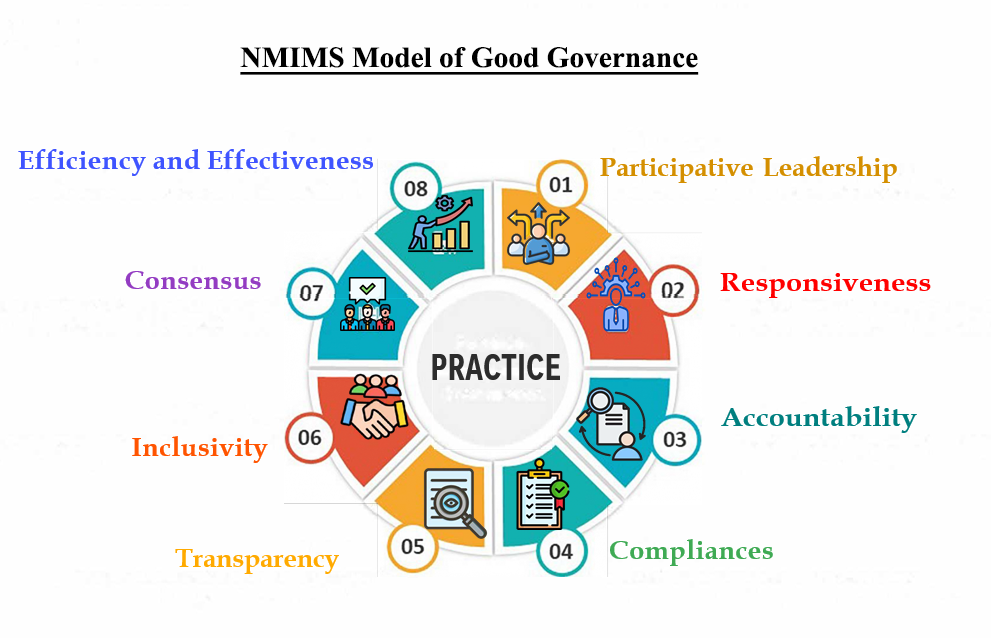The performance of the institution in an area distinct to its priority and thrust.
NMIMS University has consistently upheld its commitment to excellence in education, research, and innovation, aligning with its vision of becoming a globally recognized premier academic institution. This dedication is reflected in strategic initiatives that prioritize global recognition, academic rigor, industry connect and international collaboration. A key strength of NMIMS is its commitment to good academic governance, ensuring integrity and excellence across all operations. Acronym to University’s governance framework, is aptly named as PRACTICE, embodies core principles: Participative leadership, Responsiveness, Accountability, Compliance, Transparency, Inclusivity, Consensus, and Efficiency and Effectiveness. Together, these elements create a strong foundation for NMIMS, positioning it as a model institution in higher education and being very distinct amongst the peers.
- Participative Leadership:
NMIMS promotes a participative leadership style, wherein faculty, students, and administrative staff are all encouraged to provide input on institutional decisions. NMIMS involves various academic and administrative bodies. Key decision-making bodies like the Board of Studies, Deans’ Council, Academic Council and Board of management play an integral role in shaping the university’s academic policies, curriculum design, and overall strategic direction. This participative approach empowers faculty and administrative staff to contribute to the university's development and shared leadership.
- Responsiveness:
The university is highly responsive to both regulatory requirements and the evolving needs of its student body. NMIMS is known for its agility in adapting to changes in academic regulations, technology trends, and industry demands, ensuring its students are equipped with relevant skills and knowledge to be more employable. The implementation of e-learning platforms, online assessments, and other technological tools have further improved the efficiency and responsiveness of academic delivery.
- Accountability:
At NMIMS, faculty and staff are held accountable for academic and administrative success through regular performance reviews, audits, and feedback mechanisms. Faculty are encouraged to improve their teaching, research, and student engagement, with progress tracked through specific goals. The Career Advancement Scheme (CAS) supports faculty growth and ensures they meet institutional standards. These systems foster accountability and excellence across all the functions.
- Compliances:
NMIMS University strictly adheres to the standards of educational authorities like the UGC, AICTE, PCI, BCI and COA, ensuring academic discipline and infrastructure compliance. NMIMS norms, such as 80% attendance for exam eligibility, are rigorously enforced. Admissions are purely merit-based, with no management quota or capitation fees. The curriculum aligns with NEP 2020 guidelines. Law students benefit from state-of-the-art moot court facilities. The university also provides robust library and computer lab resources in line with all the requirements, ensuring students have access to the latest tools and technologies.
- Transparency:
Transparency is a cornerstone of NMIMS’s governance, fostering trust through open communication with students, faculty, and stakeholders. The university ensures access to information via its website and regularly shares updates through the VC Chronicle, sent to stakeholders every Monday. Key policies are clearly outlined in documents like the Student Rule Book, Faculty Handbook, and Service Rules. NMIMS also leads in technology-driven education, utilizing tools such as SAP-powered ERP, Oracle HRM, and Power BI for efficient, automated processes across Admissions, Student Life cycle management, Examinations, HR, Accounts and also has its own Institutional learning management.
- Inclusivity:
Inclusivity is central to NMIMS's educational approach, reflected in its diverse student body and commitment to equal opportunities. Scholarships, outreach programs, and support services ensure access to education for all, while an inclusive curriculum promotes critical thinking and global awareness. NMIMS supports differently-abled students with accessible campuses, assistive technologies, and tailored learning resources. The university fosters a safe, welcoming environment through anti-discrimination policies, gender-sensitization initiatives, and support groups.
- Consensus:
Oriented Decision-Making: NMIMS employs a consensus-oriented approach when it comes to major decisions regarding academic policies, infrastructure improvements, and strategic initiatives. By involving a wide range of stakeholders, from faculty to administrative staff, the university ensures that decisions are well-rounded and reflect the collective input of its community.
- Efficiency and Effectiveness:
NMIMS operates with high administrative efficiency and academic effectiveness, utilizing advanced technologies to streamline processes. SAP-powered ERP systems automate tasks like finance, procurement, and student services. Oracle-powered HRM software manages recruitment, payroll, and employee evaluations, optimizing workforce management. Power BI is used for data-driven decision-making, offering detailed reports and dashboards. On the academic side, Learning Management System (LMS) supports teaching, assessments, and communication. Advanced exam software ensures a seamless and transparent examination process. These technological solutions enhance both operational efficiency and academic delivery, supporting NMIMS’s mission for excellence.
Conclusion
NMIMS's journey toward global recognition has been strategically aligned with its robust governance structure. With a clear vision to rank among the top 5 universities in India by 2025, the top 25 in the Asia-Pacific region, and within the top 500 globally by 2030, NMIMS is focused on fostering academic excellence on a global scale. This vision is driven by a commitment to good governance, embodied in the PRACTICE principles. One of NMIMS's standout achievements in this regard is its strong presence in both national and international rankings & Accreditations. For example, the university's Pharma program consistently ranks among the top 10 in India according to the (NIRF), School of Business Management (SBM) has earned two of the most respected international accreditations: AACSB (Association to Advance Collegiate Schools of Business) and EQUIS (European Quality Improvement System). Fewer than 5% of business schools worldwide hold these accolades, highlighting NMIMS's commitment to delivering world-class education that meets the highest standards of quality. The university also holds a prestigious NAAC A+ accreditation in its fourth cycle and has been granted autonomy by the University Grants Commission (UGC).
NMIMS’s pursuit of global recognition, guided by its PRACTICE governance model rooted in technology, accountability, and transparency, enhances operational efficiency and fosters participative leadership. This approach builds trust among stakeholders and solidifies NMIMS’s standing as a premier educational institution both in India and globally. With prestigious accreditations such as NAAC, AACSB, and EQUIS, NMIMS sets a high standard for academic excellence, serving as a benchmark for institutions across India and the Asia-Pacific region.
